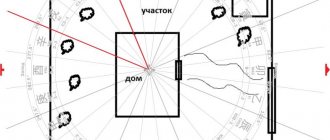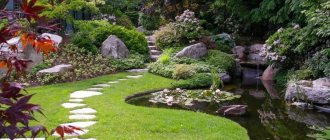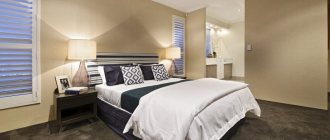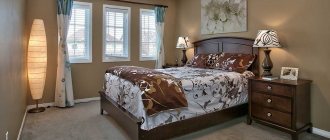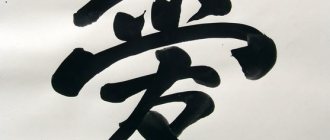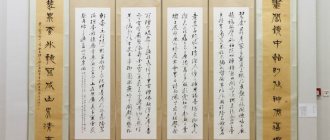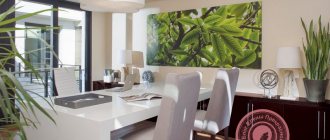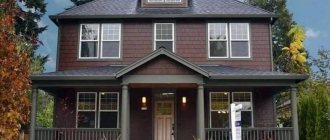Color combination of fence and facade
The shade of the fence sets the general direction of the design of the site, because it is the fence that first meets a person when approaching the house. The classic rule for selecting the shade of a fence is: “dark top – light bottom.” This solution is considered traditional, so a dark-colored roof and fence in combination with a light facade are used by designers quite often. You can make all the main elements (facades, roof, fence) dark, while choosing the finishing (windows, doors, veranda, gates, drainage system) in light colors.
When designing a site, style plays an important role. So, for a country-style home, a fence made of natural-colored wood coated with stain (oak, walnut, cherry and others) is ideal. For a castle-style house, it is worth choosing fences made of natural stone and brick.
Shrubs
And yet, most gardeners strive to decorate fences with more “solid” plants. For example, bushes can be used to camouflage an inconspicuous fence and reliably isolate oneself from neighbors. They are easy to care for. As a rule, they do not entwine the fence and do not spontaneously grow throughout the area.
What bushes are best to plant along the fence? Among the most popular is derain. It has an unusually interesting color with a silvery touch. And if you place low conifers nearby, the composition will turn out to be very interesting.
Derain is easy to cut and shape. It forms perfectly and quickly forms reliable protection against dust.
If you plant a seedling in the spring, then by the beginning of autumn it will be a meter tall. Many are attracted by such a new settler, but we must keep in mind that the derain needs a decent living space. Therefore, if you want to see more different bushes along the fence, you need to take a closer look at other species.
A good idea is to plant Thunberg barberry along the fence. These bushes have a beautiful spherical shape and reach a height of 90 cm. The matte leaves acquire a red-yellow hue with the onset of autumn. The fence looks very impressive at this time.
When planting, you should take into account that barberry does not like shaded places and does not react well to cold northern winds, so it is better to place it on the western or southern side of the fence. But gardeners will have no problems with watering: rainwater is enough for barberry.
Derain and barberry do not tolerate proximity to each other, since they have different requirements for the composition of the soil and the amount of moisture. Some of these bushes will not demonstrate their best decorative qualities.
What’s wrong with spirea, which is also called viburnum-leaved vesicle? It also grows quickly; literally a few months after planting, the bushes, strewn with luscious foliage, form a full-fledged hedge.
But to complete the picture, the spirea definitely needs to be cut so that it is not shapeless.
Take a closer look at such famous shrubs as lilac, hawthorn, elderberry, and chokeberry. All of these plants are fast-growing and can hide a fence in a short time. You can plant them in groups, with lower, trimmed bushes in front of them. Very original options can come out.
Well, if the owners want to combine business with pleasure, then they can plant berry bushes along the fence. Here you have a fence and an annual harvest of raspberries, currants, gooseberries, and rose hips.
Very important! Shrubs should not be placed close to the fence. When planting, dig holes at a distance of 1-2 meters
The usual picture: in most summer cottages, fruit trees grow along the fences, performing a double function: they serve as a fence and regularly bear fruit. However, recently, summer residents have been thinking not only about benefits, but also about beauty, and are striving to surround their properties with ornamental trees. Luxurious maples, chestnuts, modest willows, birches, and lindens are planted.
But coniferous trees, especially spruce, can probably be called gardeners’ favorites. However, by doing so, summer residents are restoring the old tradition of decorating their farmsteads with conifers.
This should not be done spontaneously. In order for a composition of young Christmas trees to be truly beautiful, you need to plant them at a distance of about 30 cm and monitor their development, constantly cutting them in width and height.
What types of decorative fences there are - original and different - can be found in our article.
Location Features
By learning to understand and use energies effectively, you can create a serene, peaceful, environmentally friendly space. Polluted and noisy places kill the power that brings good luck. Therefore, it is advisable that the house and garden are located as far as possible from roads, sources of disturbance. The Chinese claim that only fresh air and clean water attract money and improve well-being.
The entire site should be designed to have natural barriers for protection and privacy. By surrounding yourself with a wooden fence or dense hedge, you can reduce noise and weaken sharp gusts of wind. But too dense planting increases humidity, and tall trees along the entire perimeter interfere with normal air circulation.
The gate and entrance are designed in accordance with the side of the world on which they are located. By adding the necessary elements, you can protect yourself from negativity, suppress negative energy coming from the outside world, and activate positive energy. So, already from the threshold, every person entering the house is cleansed by a stream of a kind of energy shower, washing away excess, and receives a charge of strength.
Having established clear external boundaries separating from the outside world, there are a minimum of barriers inside. Low-growing shrubs, trees, and flower beds help create open space. This is how vital Qi moves freely throughout the garden. Leave free space in front of the front door without planting tall and wildly flowering plants near it. The freer the energy flows in this area, the more positive changes it brings. The center is the best place for home. If it is located in another area, then plant a large flower bed in the middle.
What trees to plant along the fence
Trees for planting on the outside of the fence
Trees on the outside of the street, in addition to their aesthetic function, act as a kind of filter that traps street dust and exhaust gases. For the outside of the fence, trees that can withstand pruning well and are not too valuable or rare are suitable, this will help avoid vandalism. In addition, you need to choose plants that are unpretentious and resistant to frost, drought and other unfavorable conditions. The following are most suitable for these purposes:
- small-leaved elm
- common elm
- Rowan
- river maple
- Tatarian maple
Common elm
In the wild, the common elm is distributed almost everywhere in deciduous forests. It is found in the European part, in Siberia, the Caucasus, and the Baltic states. In Kazakhstan. The tree grows up to 25 meters in height. The plant is shade-tolerant and drought-resistant.
Elm has been used in landscaping for a very long time, due to the fact that it not only tolerates shearing well, but also holds its given shape well. Has many decorative forms:
- silver-motley
- golden-variegated
- red
The disadvantages of elm plantings include their demands on soil fertility. On poor soils, the growth of these trees slows down. In addition, elms can attract unwanted pests and be actively damaged by them. An undoubted advantage is that the common elm lives for a very long time, up to 200-300 years.
Conifers for the inside of the fence
On the inside of the fence, you can plant primarily coniferous trees with slow growth and with decorative needles and crown. In addition to being decorative, coniferous trees purify the air and emit phytoncides that are beneficial to health. In the summer, bright annual flowers can be planted near the plantings to create a contrast with the dark needles.
Suitable for planting near the fence on the inside:
- low-growing species of prickly spruce
- medium-sized species of common spruce
- decorative types of spruce
Norway spruce Acrocona
This species grows no more than 8 cm per year, an adult plant is no more than 3.0 m in height. The crown is conical, with a wide base up to 4.0 m. needles of rich green color. Young pink cones make the trees elegant and attractive. This species does not tolerate dry soils with high salinity.
In addition to spruce trees, low-growing thujas and pines can be grown along the fence. larches. Despite the variety of species and varieties of coniferous and deciduous trees, most property owners when decorating fences give preference to unpretentious shrubs.
Time to plant trees and shrubs along the fence and paths
In order for the plants to successfully survive the winter period, saturated with low temperatures and powerful winds, when planting, listen to the advice of experts and pay attention to the following points:
1. When planting trees and shrubs, step back from the fence to the distance required for the development of the plant. Otherwise, the roots may destroy the fence, and the crown may shade the neighboring area, causing displeasure to the neighbors. The generally accepted distance from the fence for a tree is 3 m, for a bush it is 1.5 m.
Table of distances between plantings
2. Move large trees at least 5 m away from the fence. They subsequently form a powerful crown and grow significantly higher than the fence.
3. When planting plants, you need to ensure that there are no places with stagnant air on the site. During winter frosts, seedlings in this area may freeze.
4. It is also necessary to retreat about seven meters from the residential building, otherwise the tree may destroy the foundation with its roots.
5. When planting, retreat significant distances from the water supply.
6. Keep trees and shrubs, especially those that produce edible fruits, away from the drainage pit.
The most appropriate time to plant trees and shrubs along the fence and paths is generally considered to be autumn. There is a rule that bushes and trees that bloom in spring are best planted in the ground in the fall. Vegetation takes root well in spring and blooms in late summer.
Shrub planting scheme
Based on these recommendations, it is better to postpone planting until the autumn. This must be done before frost, it is advisable that the plant has time to take root. Most often, plant transplantation is performed in October. If there is a need to do this later, but the frost has not yet set in, you can carry out the work, but provide additional insulation. To do this, add sawdust or peat near the trunk.
Mulching bushes along the fence with sawdust
During frosts, replanting trees and shrubs is not recommended. It is better to simply dig them in in an inclined position, cover the roots with a layer of peat and soil, and plant them in the spring.
Digging seedlings for the winter
When choosing trees and shrubs for planting along the fence and paths, take into account the recommendations given in the article. They will help you properly organize the green space of your suburban area. Receive aesthetic pleasure, relaxation and enjoyment from country life.
Which color should I choose?
There are 213 colors of corrugated sheets
When choosing corrugated sheeting, they start, first of all, from the goal and task - what will be made of it.
Roofing and fence require different thicknesses of metal and the type of profile for them will also be different. But the choice of corrugated sheet color is no less important.
Firstly, the color coating changes the quality characteristics of the corrugated sheet. Due to the fact that the coating comes in different thicknesses and structures and is made with different paints, the service life of the material varies.
A fence made of unpainted galvanized corrugated sheets is less durable than one made of polymer-coated corrugated sheets.
Secondly, the aesthetic appearance of the house, site, and the entire ensemble as a whole depends on the design of the fence. By choosing the wrong color of corrugated board for a fence, you can “kill” the entire landscape design. Or you can make the house sparkle and look much more respectable.
How to choose a fence color: 7 rules
You can easily choose the color of corrugated board for a fence if you know simple rules.
- The main rule: the color of the roof matches the façade of the house, and the color of the fence matches the roof. It can also be used for the building as a whole. But here a lot depends on the taste of the owner. For example, today the Mediterranean style with light pastel colors is in fashion. In this case, a fence made of light gray corrugated sheets will look very harmonious with a bright blue metal roof.
- Customer's desire. What does he strive for: to surprise, to distinguish himself from his neighbors, or to do “like everyone else”? Each task has its own shade.
- If the fence posts are stone, the color choice is usually limited to chocolate brown or beige. It turns out very elegant.
- If the yard is small, then a fence made of gray corrugated board will help to visually enlarge the space.
- If you want security, and the size of the yard differs in scale, then feel free to choose a dark shade of corrugated sheet.
- If the house is lined with wild stone, if it has a white or gray plastered facade, then a fence made of red corrugated sheets will be a bright accent and decoration.
- If you want the fence to blend in with the environment, then you don’t need to choose a fence made of green corrugated board, choose one made of blue, matching the color of the sky. A blue fence made of corrugated board, in addition, looks very elegant.
Click to enlarge
The most popular colors (in harmony with nature):
- Brown and dark brown;
- Dark green and green;
- Burgundy or wine red, Brazilian cherry color;
- Blue;
- Light grey.
The most risky colors for a fence (you need to know how to work with them):
- Red;
- Yellow fence made of corrugated board.
The latest ideas for colored corrugated sheeting:
- Sheets with a pattern imitating wood texture.
- With a pattern imitating the texture of stone and brick.
- With camouflage pattern.
Creating an entrance
The fence gate should not be located opposite the doors. This is considered a bad sign in Feng Shui: the energy will “walk”, as if in a draft. How to login correctly:
- It’s also not a good idea to place the entrance to the area behind the building: it’s ideal to place it at an angle so that the gate can be seen from the entrance doors.
- The gate should be medium in size: an entrance that is too wide or narrow interferes with the movement of energy.
Article on the topic: Is it possible to install a barbed wire fence?
The shape chosen is rainbow-like (round). Sharp corners in the teaching are considered too rough, while rounded ones soften the flow of energy to the site and into the house.
Bells or jingling coins are hung above the gate. This way the wind will bring wealth to the site. If the house is located near a road or highway, the front entrance is moved further away and fenced off with green spaces.
Foundation
This is what a fence looks like on a site with a slope
The foundation construction technology differs depending on the magnitude of the difference between the upper and lower points of the fence.
It is important to take into account that in lowlands the base of the structure is laid at the same height as the ground surface, in high places - according to the calculated depth, which is determined from the formula:
- lt = lpv + lp
- where IT is the depth of the trench,
- Ipv - the magnitude of the difference in heights of the area,
- Ір is the thickness of the plant layer.
Small to medium slope
The arrangement of the foundation depends on the magnitude of the slope. In this case, even differences of 10–20 cm are taken into account, for which geological outlines are first created. Neighboring piles are installed closer to each other.
When installing a corrugated fence on an uneven surface with a slope, holes for the columns are drilled to the depth of soil freezing - from 100 to 150 cm. In general, they should be 25 cm below the base.
All excavations are made at the same level - the height of the base and the depth of the foundation must be the same along the entire length of the fence.
It is worth noting that when the lower boundary of the fertile layer lies deeper than in other places, the pit or trench is deepened until this layer is exhausted
If the slope along the length of the future corrugated fence is not uniform, then it is possible to build landscape steps.
Small slope
A difference is considered small when the height of the ground surface between the extreme points of support is less than the design depth.
Digging a trench under an uneven fence made of corrugated sheets begins from the highest point of the site.
Instead of a fill of soil, a concrete base is sometimes built. Then there is a minimum gap at the bottom of the fence, and a parallel with the foundation at the top.
Average slope
Installation of a corrugated fence on a slope is carried out in this way if the difference between the soil surface between the extreme points of support is the same as the calculated depth, or more than a maximum of 20 cm.
The installation of each new span on an uneven surface is carried out lower than the previous one. Marking work here and at greater slopes is carried out from the lowest point.
In the low part, the depth of the trench is the same as the depth of the anti-heaving cushion, but not less than the depth of the fertile layer. Other developments are carried out at the same level.
Big drop
A slope is considered large when the difference between the upper and lower points is 100 cm or more.
They build a stepped type of foundation. In lowlands, installing a fence made of corrugated sheets on an uneven area involves laying the base level with the ground surface.
The transition to the next level is carried out through 1–2 ledges. In this case, the length of the ledges is 2–3 times greater than the height. The ledge height is not allowed below 60 cm.
Shrubs
You can hide an unsightly fence with the help of bushes. Decorative varieties include lilac. It is unpretentious in care, able to please with beautiful flowering and a pleasant aroma.
Tumberg barberry will help decorate the fence. The shrub grows up to 90 cm and is shaped like a ball. In autumn, the leaves turn red with a yellow edge. Barberry does not need additional watering; it gets enough rain, but it is demanding on lighting. In addition, the plant does not like cold, so it is better to plant it on the south side of the site.
Spiraea is popular among summer residents. This is an unpretentious shrub. It attracts with its abundant flowering and high growth rate. The bush must be pruned in a timely manner so that the plant does not acquire an unkempt appearance. Today there are many varieties of spirea. They differ in the color of leaves and flowers. Read more in the article.
A favorite among dacha owners is derain. It grows quickly and the castings are painted silver with white edges. If you plant several bushes in the spring, then by autumn you can get a finished hedge up to 1 meter high. It is necessary to take into account that derain requires a lot of space, so combining it with other shrubs will not work.
Latest posts Ingenious tricks for growing tomato seedlings from experienced gardeners 6 ideas on how to use cut branches in the country and at home What to put in the ground when planting cucumbers for seedlings so that powerful vines will form by the summer season
Along the fence you can plant fruit bushes such as raspberries, currants, blackberries, and honeysuckle. While currants are fairly easy to care for, raspberries and blackberries can present certain difficulties. When planting blackberries, you must ensure that their branches do not touch the ground, otherwise they will sprout. Raspberries constantly have shoots on their roots. If it is not removed in time, then neat bushes will turn into impenetrable thickets.
Honeysuckle is very unpretentious and easy to care for. It has oblong blue berries that taste good. These are the earliest berries that you can try in the country. Honeysuckle branches heavily, so the branches should be trimmed periodically. But thanks to this quality, it can be made into an excellent hedge. The main thing is to give it shape using scissors.
Chokeberry is also well suited for planting in the country along the fence. In spring, delicate pinkish inflorescences look beautiful against the background of dark green leaves. In summer, rowan will delight you with a bountiful harvest of black, sweet-tart berries. In autumn, the plant will attract the eye with bright red foliage.
Unusual rose for March 8th.
I have already gotten used to the fact that by February 14 and March 8, they order only roses from me in different interpretations.
But this time the order was really strange, unusual and interesting) We ordered THROWING roses O_o
Well.. — I thought — everyone has their own methods of conquering girls) It turned out that the customer is a member of the Federation of Professional Knife and Ax Throwing, which is in St. Petersburg) By the way, he is a very charismatic and pleasant person).
What fence color to choose according to Feng Shui?
If you live in an apartment, then there is nothing difficult in arranging its interior space according to all the rules of Feng Shui. This will ensure safety and harmony. But what if your home is really a real house, a country house or simply located in the private sector? Where should you start arranging your home according to the rules of Feng Shui?
The main function of a fence as a physical object is protection. In Feng Shui, it performs the same function, but the fence protects not from intruders or thieves, but from the negative Sha energy. Also, the fences around the site seem to attract certain types of energy forces. The shape and color of the fence determine the mood in your family, the number of conflicts, as well as harmony or lack thereof in the house.
First, you should consider the different colors that a fence can be painted in and understand exactly what effect this will have on your life and the lives of your household.
black fence
You should not paint the fence black, as this color creates a gloomy atmosphere. It is highly undesirable for you to see this color often, as it reduces the level of Qi energy.
If the fence is painted black on both sides, this will double the negative impact.
White fence
A white fence is also a bad feng shui idea. Although the white shade is the color of purity, it also carries the function of an energy vacuum. This color represents death.
Sooner or later, such a fence will leave both you and your area without a drop of energy.
purple fence
The color violet itself represents greatness and high mental qualities. A fence of this color will somewhat elevate you and your home, and will also improve the flow of positive Qi.
Green fence
Paint the inside of the fence this color, this will give the entire space inside your site a restorative function. Thus, the area inside such a fence will turn into a powerful, harmonious and peaceful area.
Blue fence
A fence of this color will bring relaxation to the site and to the home itself. It will somewhat reduce energy activity and its strength.
Use this color only if you need calmness, since your home is constantly filled with seething and chaotic energy (this is most often found in densely populated houses).
yellow fence
An excellent color for a fence, just don’t use bright shades. Too bright yellow color provokes aggressive behavior and causes excessive irritability, since it carries the energy of Yang male power. This color can also evoke anger and fear.
Create a fence in softer shades of yellow, such as gold. This will give your home an invigorating effect, and inside such a house you will feel extraordinary optimism.
Red fence
This color is one of the most powerful in the practice of Chinese Feng Shui.
But it should be used with extreme caution, since it carries too much energy and an excess of red can lead to incredible aggression
If you want to add this color when painting your fence, then choose more muted shades of red. This will allow you to bring a powerful flow of energy into your home, but at the same time it will not be as destructive as fiery crimson. Also, a fence of this color is contraindicated for people who are usually irritable.
It is not necessary to use the same color for both sides of the fence. Use the colors you would like to achieve inside and outside.
For example, the outside of the fence can be blue to have a calming effect on others and external energy, and inside it can be green to quickly restore the strength of the people living in the house.
Do not use too bright colors to decorate the fence. This applies to absolutely all zones and the entire color palette. Muted shades almost always have positive effects. Remember the golden rule - everything is good in moderation.
If you need a powerful influx of energy into your home, then just choose a burgundy color; there is no need to paint the fence bright red, this will only cause harm and cause discord in the relationships within the house.
Wooden fencing
Different materials are used to install fences. If it is wood and metal, you have to periodically coat the products with protective compounds that can protect the base from weather influences. Painting helps to do this very effectively; it also improves aesthetic perception.
When deciding what color to paint a wooden fence, it is important to take into account the height of the fence and its main function. If it is just a picket fence that marks the perimeter of the site, if you need to clearly indicate its presence, it is better to use white. It is good when the house is designed in the form of a merchant estate, when there is openwork decor made of wood on its facade. It will be easily supported by a light fence.
Article on the topic: How to build a chain-link fence with your own hands
Green and brown shades significantly simplify the composition and look quite trivial. If it is difficult to choose what color to paint a wooden fence, you need to look at the color of the roof and choose a color to match it. If they coincide, the design of the site will look harmonious.
When a picket fence is used inside the home area to form flower beds and play areas for children, each lamella can be painted a different color. A fence painted in all the colors of the rainbow always looks great, it brings a touch of playfulness to the landscape design and acts as an accent decoration.
If the house is made of logs and looks like a Russian tower, to create a cohesive picture, it makes sense not to paint the fence and leave the color of natural wood. To extend the life of the fence, you need to use antiseptic impregnations or passivating paints. They form a protective layer, but do not hide the natural texture pattern.
To paint a fence, it is important not only to choose the right color, it is important to know how to beautifully paint a wooden fence and do this job efficiently.
Experts recommend:
- When installing the fence, use collapsible structures, first paint each element separately with one layer of paint (this will cover its entire surface), and then paint the finished fence again.
- For decoration, use paints that do not fade in the sun, retain color fastness, and have sufficient consistency for economical application.
- The paint should protect the wood from pests and should not be highly toxic.
The painting technology is extremely simple. First, the dirt is cleaned from the base, then the cracks are repaired with a primer. Using a special apparatus, the surface of the wood is sanded and then coated with an antiseptic composition. The paint is applied after it is completely dry.
Ideal fence color according to feng shui
Natural stone can be left in its original form; such a fence is almost never painted or plastered, since such a fence not only has a powerful energy force (like a natural element), but also looks quite expensive and impressive.
Other fences, for example, those made of brick and wood, can be coated with paint of a suitable shade
It is important to remember that the northern and western parts of the world love cold and dark muted shades, but the eastern and southern parts love warm and brighter shades. Sand, caramel, orange and terracotta tones are suitable for painting a fence on a site in the southern and eastern zones
Areas located in the northern and western parts are in perfect harmony with bluish and bluish tones, silver and moderately dark.
When choosing the shade of a fence, it is, of course, important to consider not only Feng Shui compliance, but also how such a fence will combine with your entire site and exterior. If the fence sharply contrasts in color with the house and garden, this will create an imbalance and lead to a feeling of wariness and nervous tension among its residents
And, on the contrary, if the shade does not quite match the direction of the light or the material of the fence, but at the same time wonderfully combines and harmonizes with the tones of the entire country house, then this will have a favorable effect on the feelings of the residents.
Feng Shui does not tend to highlight the fence as a separate pile on the site
On the contrary, an ideal fence fits completely into the overall appearance of the site, does not stand out from it in any way, and certainly does not draw attention to itself. A simple and elegant fence in a minimalist style is the most optimal solution
You should not show excessive imagination or originality, trying to surpass your neighbors or make your site special.
Bright fence color
Also avoid too bright shades, as was written above - they concentrate too much Qi energy around the fence, and therefore it practically does not get inside, being useless for the inhabitants of the house. Too dark and gloomy colors are also a bad solution for a fence.
Dark fence color
If you use rich dark colors to paint the fence, then let it be small details or separate decor, or dilute such shades with light warm colors (for example, beige, peach or pale yellow).
White fence color
Very often, people try to make their site visually lighter and more open with the help of a wooden palisade, painting it white. Wood is one of the five most important elements of Feng Shui, which is why it itself has great energy power.
So you already know - this is a kind of leveler and deactivator of any energy. In small quantities it is useful and must be in the house and on the site, but a solid white fence will erase all the energy power of the tree, making it simply useless. If you are striving for the lightest shades, then it is better to choose light blue, pale pistachio, beige or light gray instead of snow-white.
Installation of fences of all types. Professional construction of fences inexpensively
Home » Useful materials » Install a wooden fence according to Feng Shui
Install a wooden fence according to Feng Shui
We Europeans are not inclined to philosophize about everyday things. If, for example, we decide to put up a wooden fence for a site, then we are guided by quite earthly principles: what material to order it from, how much will it cost, what color to choose for it, how many years will it last, is it easy to maintain, will it protect against the noise of cars, will it hide it from prying eyes, etc., etc. As for the size, let the fence be higher. As for the shape, let it be beautiful and non-standard.
Call by phone. Our specialists will give comprehensive answers to all your questions.
If you were Chinese, such a simplified approach to such an important matter as making a fence for a summer house would, at best, plunge you into deep despondency. Thus, the Chinese do not do such things, because we are not talking about something meaningless and fleeting, but about the space in which you and your family members will spend years of your life. The fence must be positioned correctly! Have the right form! Climb to the correct height! Otherwise, all energy flows will go in the wrong direction and it is not known how this will affect your entire future life.
Every Chinese who considers himself educated will definitely check the science of Feng Shui and do exactly as its rules require.
Feng Shui (for the uninitiated) literally means “wind and water” and is the ancient art of controlling natural energy flows. It originated in China many hundreds of centuries ago, developed, improved and spread throughout countries and villages. Feng Shui has its own view of all the things that surround us. Following the laws of Feng Shui is a personal matter for everyone, but many people in our big world are sure that organizing living space in accordance with Feng Shui brings logic to it, promotes success, wealth, family well-being, etc. - that is, everything what each of us tries to achieve in our lives through great effort.
